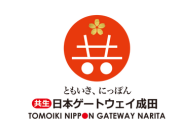This is about 10% of the annual volume generated here during the 3rd-7th centuries CE – the Byzantine era – when grapegrowing, winemaking and trading wine were the main occupations of the 75,000 residents living in the six towns and hundreds of farmsteads that made up the Negev at its peak. When the region had nearly 25,000 dunam (6,177 acres) of vineyards.
The Byzantine era is also when the highest part of the region – the Negev Highlands (700–900m asl) – became a wine appellation of international repute, sending its sweet wines throughout the Mediterranean (France, Italy, Greece, North Africa and Anatolia), as well as inland to Germany, Switzerland and Britain in 25-35L amphorae from two ports, Gaza and Askelon.
Some of the grapes growing then were relatives of heritage white grapes such as Israel’s Be’er and Armenia’s Dabouki, and black grapes such as Greece’s Syriki (Assouad Karech in Lebanon).
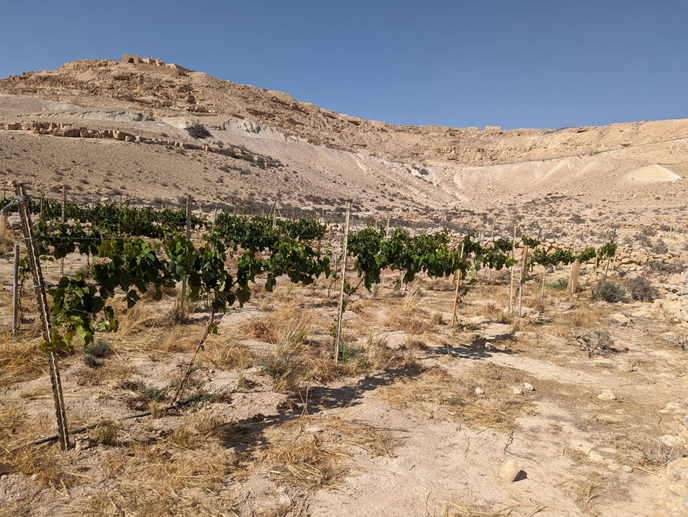
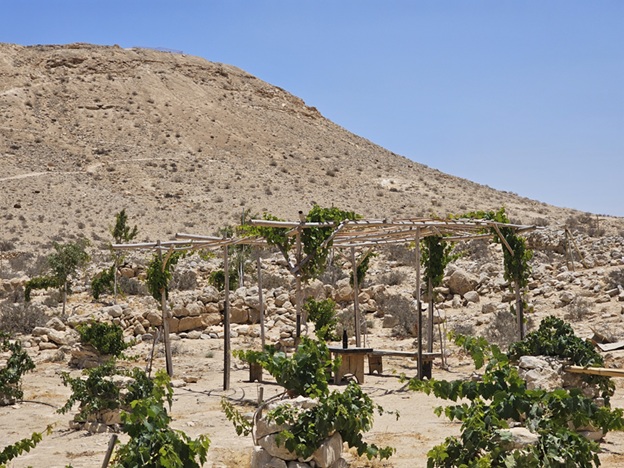
Heritage grapes growing in a revived vineyard at the foot of Avdat.
I’m pleased to hear these ancient grapes are once more being nurtured here. And, as they show great potential for producing high-quality wines in drought-like conditions, they are likely to be of interest to wine producers facing increased heat in the Mediterranean region.
As the researchers who planted the heritage grape varieties in a 1.2ha experimental vineyard at the foot of Avdat say: “The hardiness of the Negev wine grapes and their proven ability to adapt and thrive in parched climes are especially valuable traits in an era in which rising temperatures are set to severely disrupt traditional wine-growing regimes. Indeed, the approaching untenable temperature increase is leading contemporary vine-growers and winemakers the world over to seek cultivars that possess proven resilience to heat and the associated effects of desertification.
“As determined by our research findings, the feral grapevine cultivars that we planted in the Avdat vineyard possess a traceable paleogenetic footprint with ancient local grape species that gained legendary status by, over time, acquiring an enduring resilience to their arid surroundings. Thus, we suggest expanding the empirical Negev heritage vineyard concept currently unfolding at Avdat to include the use of autochthonic grapevine cultivars in additional Negev vineyards.”
Historic viticultural practices
The researchers from the University of Haifa’s School of Archaeology and Maritime Cultures are also looking at historic viticultural practices to see if they also offer potential solutions for winegrowers in arid areas.Dryland farmers in the Byzantine Negev Highlands used floodwater to irrigate their vines – channelling seasonal rainstorm run-off down the hill slopes and into the terraced plots below. The seasonal floodwater that collected along the valley floors gradually seeped beneath the hardened loamy surface where it remained trapped in underground limestone aquifers several metres beneath the ground. Over time, these grape cultivars developed deep root systems that could tap into the available subterranean water sources.
To supplement the vineyards’ micronutrient deficient soil, Negev farmers erected dovecotes near the vineyards to house hundreds of pigeons – generating organic guano fertiliser.
By contrast, 21st century Negev vineyards grow international grape varieties, such as Syrah, Petit Verdot, Barbera, Malbec, Chenin Blanc and Colombard, and are irrigated with manufactured water. In water-scarce Israel, major portions of the country’s water supply are sourced from desalinated Mediterranean seawater that is processed at coastal reverse osmosis plants, located far from the desert viticulture sites. To ensure that the grapes receive enough water at affordable prices, in 2010 the national government undertook the construction of an in-situ industrial water supply system for the farms in the Negev Highlands.
In conjunction with the Jewish National Fund, a prominent Jewish NGO focused on settlement and development in Israel, a wastewater treatment facility was built that converts pools of raw sewage from Mitzpe Ramon, the main town of the area (pop. 5500), into agricultural grade water. Irrigation from this source is achieved via rugged PVC tubing that is stretched along the vineyard rows and fitted with individual emitters. Water lines are positioned at the base of the vines and enclosed in sheets of reinforced white plastic to maintain low temperatures and prevent weeds from sprouting, while also helping to reduce vapor evaporation due to the intense sun. The reclaimed water is supplemented with chemical nutrients and conventional fertilisers that are dispensed throughout the growing season.
'This research underscores the significance of historical knowledge in contemporary agriculture'“Vineyards are an inherently long-term investment, and understanding the historical context of viticulture in arid regions like the Negev can provide modern winemakers with essential insights,” says Dr Joshua Schmidt, one of the lead researchers. “Our findings suggest that reviving and incorporating historical cultivars, along with the agronomic practices that supported their growth, can significantly enhance the resilience of vineyards in the face of climate change.”
Another of the lead researchers, Prof Guy Bar-Oz, adds: “This research underscores the significance of historical knowledge in contemporary agriculture. By understanding how past farmers successfully navigated the challenges of their environment, we can inform current practices, enhance the sustainability of the wine industry at a time when it is under significant threat, and preserve the rich viticultural histories and lineages in wine-growing regions.”
Key recommendations in the paper
Key recommendations in the paper, ‘Propagating Terroir Revival in the Negev: How the Wine Industry Can Amplify Its Resilience to Climate Adversity through a Deeper Understanding of Historic Dryland Viticulture’, include the revival of endemic grape cultivars and the application of traditional agronomic techniques that have proven effective in the past. These strategies not only aim to improve grape quality and yield but also to foster a deeper connection between winemakers and their local terroir.The paper suggests three ways the contemporary Negev wine sector can benefit from actively reviving knowledge derived from its longstanding past:
- Integrate ancient agro-technologies. One promising avenue for bridging the wine sector in the Negev with its historical roots is the integration of ancient agro-technologies. Techniques such as terracing, water harvesting, and organic soil improvement, once central to historical viticulture, can be revisited and adapted to modern contexts. These ancient agricultural methods offer solutions to contemporary challenges in regenerative agriculture, including sustainable land use, water conservation, soil improvement, and organic farming. By embracing these time-tested strategies, the wine industry in the Negev can authentically connect with its historical terroir while addressing current environmental concerns.
- Revival of historical heirloom vines. The applied resurgence of historical heirloom grape cultivars can serve to link past and present Negev viticulture. By reviving these indigenous varieties, the wine sector can capture the essence of the historical Negev terroir, recreating flavours and characteristics that are deeply embedded in the identity of the regional cultivars. Furthermore, the revival of these cultivars can contribute to biodiversity preservation and add distinctive value to Negev wines, fostering a unique niche in the global wine market.
- Develop eco/edu tourism programs that connect historical and modern wine routes. To celebrate the rich history of viticulture in the Negev and create a harmonious blend of historical and modern wine experiences, the development of eco and educational tourism programs is essential, say the researchers. By establishing wine routes that connect historical sites, vineyards, and modern wineries, visitors can embark on a journey that weaves together the threads of the regional vinicultural heritage. These programs can offer a unique opportunity for tourists to actively engage with the compelling cultural history of Negev viticulture. Through guided tours, workshops, and tastings, eco/edu tourism fosters a deeper appreciation for the terroir-driven wines of the Negev while promoting sustainable practices and community involvement.

 English
English French
French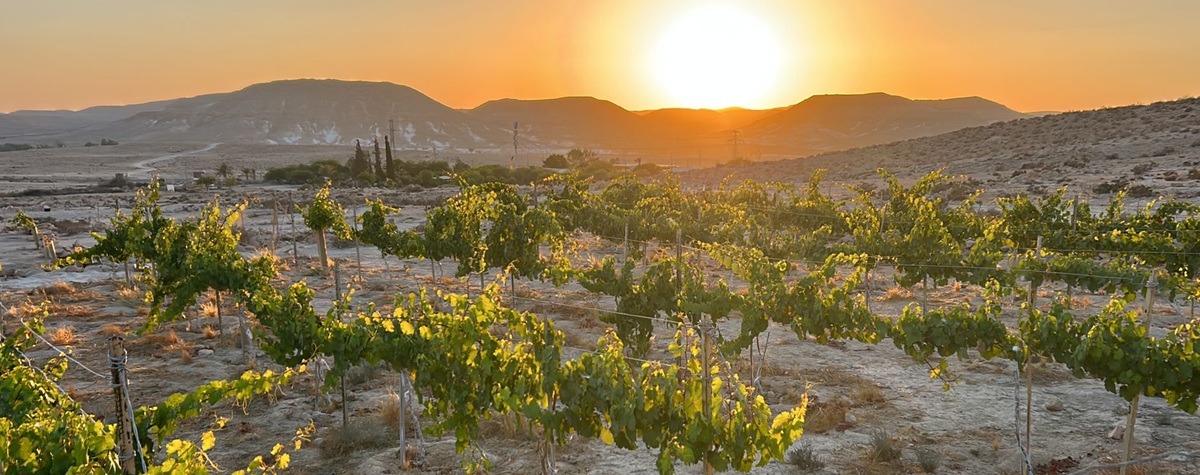

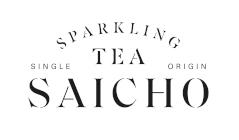




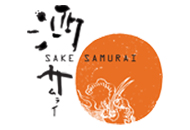
.png)
